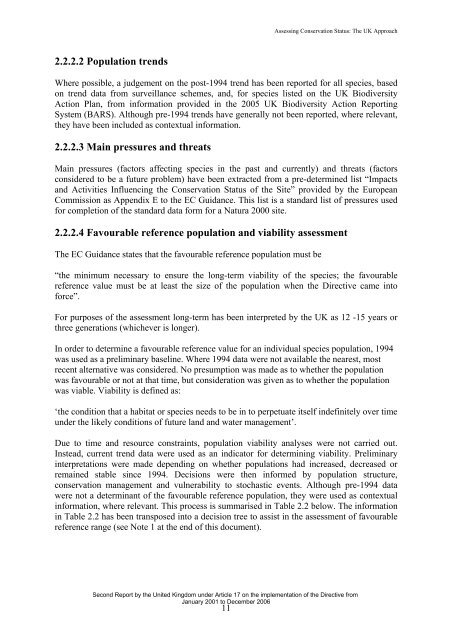Assessing Conservation Status: The UK Approach - JNCC
Assessing Conservation Status: The UK Approach - JNCC
Assessing Conservation Status: The UK Approach - JNCC
You also want an ePaper? Increase the reach of your titles
YUMPU automatically turns print PDFs into web optimized ePapers that Google loves.
<strong>Assessing</strong> <strong>Conservation</strong> <strong>Status</strong>: <strong>The</strong> <strong>UK</strong> <strong>Approach</strong><br />
2.2.2.2 Population trends<br />
Where possible, a judgement on the post-1994 trend has been reported for all species, based<br />
on trend data from surveillance schemes, and, for species listed on the <strong>UK</strong> Biodiversity<br />
Action Plan, from information provided in the 2005 <strong>UK</strong> Biodiversity Action Reporting<br />
System (BARS). Although pre-1994 trends have generally not been reported, where relevant,<br />
they have been included as contextual information.<br />
2.2.2.3 Main pressures and threats<br />
Main pressures (factors affecting species in the past and currently) and threats (factors<br />
considered to be a future problem) have been extracted from a pre-determined list “Impacts<br />
and Activities Influencing the <strong>Conservation</strong> <strong>Status</strong> of the Site” provided by the European<br />
Commission as Appendix E to the EC Guidance. This list is a standard list of pressures used<br />
for completion of the standard data form for a Natura 2000 site.<br />
2.2.2.4 Favourable reference population and viability assessment<br />
<strong>The</strong> EC Guidance states that the favourable reference population must be<br />
“the minimum necessary to ensure the long-term viability of the species; the favourable<br />
reference value must be at least the size of the population when the Directive came into<br />
force”.<br />
For purposes of the assessment long-term has been interpreted by the <strong>UK</strong> as 12 -15 years or<br />
three generations (whichever is longer).<br />
In order to determine a favourable reference value for an individual species population, 1994<br />
was used as a preliminary baseline. Where 1994 data were not available the nearest, most<br />
recent alternative was considered. No presumption was made as to whether the population<br />
was favourable or not at that time, but consideration was given as to whether the population<br />
was viable. Viability is defined as:<br />
‘the condition that a habitat or species needs to be in to perpetuate itself indefinitely over time<br />
under the likely conditions of future land and water management’.<br />
Due to time and resource constraints, population viability analyses were not carried out.<br />
Instead, current trend data were used as an indicator for determining viability. Preliminary<br />
interpretations were made depending on whether populations had increased, decreased or<br />
remained stable since 1994. Decisions were then informed by population structure,<br />
conservation management and vulnerability to stochastic events. Although pre-1994 data<br />
were not a determinant of the favourable reference population, they were used as contextual<br />
information, where relevant. This process is summarised in Table 2.2 below. <strong>The</strong> information<br />
in Table 2.2 has been transposed into a decision tree to assist in the assessment of favourable<br />
reference range (see Note 1 at the end of this document).<br />
Second Report by the United Kingdom under Article 17 on the implementation of the Directive from<br />
January 2001 to December 2006<br />
11
















